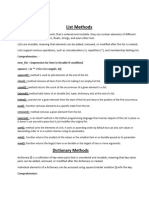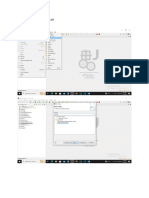Learn Python 3 - Dictionaries
Uploaded by
Cleber_Rocha_SantosLearn Python 3 - Dictionaries
Uploaded by
Cleber_Rocha_SantosCheatsheets / Learn Python 3
Dictionaries
Accessing and writing data in a Python dictionary
Values in a Python dictionary can be accessed by
placing the key within square brackets next to the my_dictionary = {"song": "Estranged",
dictionary. Values can be written by placing key within "artist": "Guns N' Roses"}
square brackets next to the dictionary and using the print(my_dictionary["song"])
assignment operator ( = ). If the key already exists, the
my_dictionary["song"] = "Paradise City"
old value will be overwritten. Attempting to access a
value with a key that does not exist will cause a
KeyError .
To illustrate this review card, the second line of the
example code block shows the way to access the value
using the key "song" . The third line of the code block
overwrites the value that corresponds to the key
"song" .
Syntax of the Python dictionary
The syntax for a Python dictionary begins with the left
curly brace ( { ), ends with the right curly brace ( } ), roaster = {"q1": "Ashley", "q2": "Dolly"}
and contains zero or more key : value items separated
by commas ( , ). The key is separated from the value
by a colon ( : ).
Merging Dictionaries with the .update() Method in Python
Given two dictionaries that need to be combined,
Python makes this easy with the .update() function. dict1 = {'color': 'blue', 'shape': 'circle'}
For dict1.update(dict2) , the key-value pairs of dict2 dict2 = {'color': 'red', 'number': 42}
will be written into the dict1 dictionary.
For keys in both dict1 and dict2 , the value in dict1 dict1.update(dict2)
will be overwritten by the corresponding value in
dict2 .
# dict1 is now {'color': 'red', 'shape':
'circle', 'number': 42}
Dictionary value types
Python allows the values in a dictionary to be any type
– string, integer, a list, another dictionary, boolean, etc. dictionary = {
However, keys must always be an immutable data type, 1: 'hello',
such as strings, numbers, or tuples. 'two': True,
In the example code block, you can see that the keys '3': [1, 2, 3],
are strings or numbers (int or oat). The values, on the
'Four': {'fun': 'addition'},
other hand, are many varied data types.
5.0: 5.5
}
Python dictionaries
A python dictionary is an unordered collection of items.
It contains data as a set of key: value pairs. my_dictionary = {1: "L.A. Lakers", 2:
"Houston Rockets"}
Dictionary accession methods
When trying to look at the information in a Python
dictionary, there are multiple methods that access the ex_dict = {"a": "anteater", "b": "bumblebee",
dictionary and return lists of its contents. "c": "cheetah"}
.keys() returns the keys (the rst object in the key-
value pair), .values() returns the values (the second ex_dict.keys()
object in the key-value pair), and .items() returns both
# ["a","b","c"]
the keys and the values as a tuple.
ex_dict.values()
# ["anteater", "bumblebee", "cheetah"]
ex_dict.items()
# [("a","anteater"),("b","bumblebee"),
("c","cheetah")]
get() Method for Dictionary
Python provides a .get() method to access a
dictionary value if it exists. This method takes the key # without default
as the rst argument and an optional default value as {"name": "Victor"}.get("name")
the second argument, and it returns the value for the # returns "Victor"
speci ed key if key is in the dictionary. If the second
argument is not speci ed and key is not found then
{"name": "Victor"}.get("nickname")
None is returned.
# returns None
# with default
{"name": "Victor"}.get("nickname", "nickname
is not a key")
# returns "nickname is not a key"
The .pop() Method for Dictionaries in Python
Python dictionaries can remove key-value pairs with
the .pop() method. The method takes a key as an famous_museums = {'Washington': 'Smithsonian
argument and removes it from the dictionary. At the Institution', 'Paris': 'Le Louvre', 'Athens':
same time, it also returns the value that it removes from 'The Acropolis Museum'}
the dictionary. famous_museums.pop('Athens')
print(famous_museums) # {'Washington':
'Smithsonian Institution', 'Paris': 'Le
Louvre'}
You might also like
- b07 - Process Simulate Virtual Commissioning PDFNo ratings yetb07 - Process Simulate Virtual Commissioning PDF25 pages
- Learn Python 3 - Dictionaries Cheatsheet - CodecademyNo ratings yetLearn Python 3 - Dictionaries Cheatsheet - Codecademy3 pages
- Learn Python 3_ Dictionaries Cheatsheet _ CodecademyNo ratings yetLearn Python 3_ Dictionaries Cheatsheet _ Codecademy3 pages
- Learn Python 3: Dictionaries Cheatsheet - CodecademyNo ratings yetLearn Python 3: Dictionaries Cheatsheet - Codecademy3 pages
- Learn Python 3 - Dictionaries Cheatsheet - CodecademyNo ratings yetLearn Python 3 - Dictionaries Cheatsheet - Codecademy4 pages
- Class 11 Comp Sci Assignmeent Module 1 DictionaryNo ratings yetClass 11 Comp Sci Assignmeent Module 1 Dictionary6 pages
- Learn Python 3 - Python - Code ChallengesNo ratings yetLearn Python 3 - Python - Code Challenges7 pages
- Learn Data Analysis With Pandas - IntroductionNo ratings yetLearn Data Analysis With Pandas - Introduction2 pages
- Learn Data Analysis With Pandas - Aggregates in PandasNo ratings yetLearn Data Analysis With Pandas - Aggregates in Pandas2 pages
- PLM Software: Working in Both Traditional and Synchronous Mode While Using Solid EdgeNo ratings yetPLM Software: Working in Both Traditional and Synchronous Mode While Using Solid Edge16 pages
- Outsystems Associate Reactive Developer Outsystems 11 Exam Braindumpscollection Actual Questions by Burch 15 04 2024 8qa100% (1)Outsystems Associate Reactive Developer Outsystems 11 Exam Braindumpscollection Actual Questions by Burch 15 04 2024 8qa9 pages
- Dbeaver - What Is The Reason For Not Working of 'Describe' Command On Oracle - Stack OverflowNo ratings yetDbeaver - What Is The Reason For Not Working of 'Describe' Command On Oracle - Stack Overflow2 pages
- Linux Training - The Complete Shell Scripting Course - UNIXSHELL - PDFNo ratings yetLinux Training - The Complete Shell Scripting Course - UNIXSHELL - PDF3 pages
- React Architecture Patterns for Your ProjectsNo ratings yetReact Architecture Patterns for Your Projects24 pages
- Semester - I (Ay 2020 - 21) Online Test McqsNo ratings yetSemester - I (Ay 2020 - 21) Online Test Mcqs30 pages
- Multiple Choice Questions - Practice FilesNo ratings yetMultiple Choice Questions - Practice Files28 pages



































































































